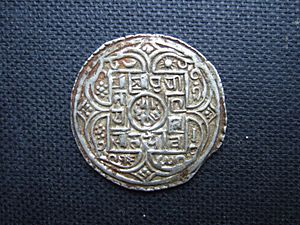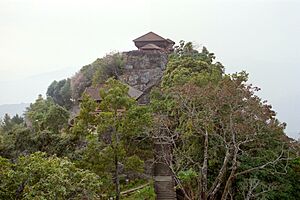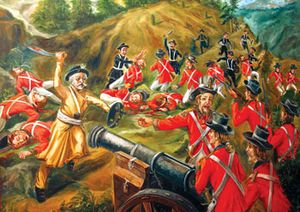History of Nepal facts for kids
Nepal's story is a mix of its own past and the history of places around it, like India and East Asia.
Nepal is a country full of different groups of people. They have many races, cultures, religions, and languages. The main language spoken is Nepali, but many other languages are used too.
The Kingdom of Nepal started in 1768. It began to bring together the lands that would become modern Nepal. Some areas were lost after the Sino-Nepalese War. This war had wins and losses. Nepal then agreed to be a tributary to China's Qing dynasty from 1792 to 1865. The Anglo-Nepalese War ended with Britain winning. This led to Nepal giving up some land in the Treaty of Sugauli.
In June 2006, the Nepalese parliament voted to end the monarchy. This was a big historical moment for the constituent assembly. Nepal became a federal republic on May 28, 2008. It was officially named the 'Federal Democratic Republic of Nepal'. This ended the 200-year rule of the Shah kings.
Contents
What's in a Name? The Story of "Nepal"
The name 'Nepal' has a cool history! In an old writing from the Licchavi period, people living there were called 'Nepals'. Experts think that in ancient times, the word 'Nepal' meant both the land and its people. These 'Nepals' are thought to be the ancestors of today's Newars.
There are also many theories about where the word 'Nepal' came from:
- Some say it comes from the Sanskrit word Nepalaya. This means "at the foot of the mountains" or "home at the foot".
- The Tibetan word Niyampal means "holy land". 'Nepal' might come from this.
- Another idea is that people from northern Nepal came from Tibet. They herded sheep and made wool. In Tibetan, ne means "wool" and pal means "house". So, 'Nepal' could mean "house of wool".
- A popular story says the Lepcha people used ne ("holy") and pal ("cave"). This would make 'Nepal' mean "holy cave".
- In Hindu stories, Nepal gets its name from an old wise man named Ne. He was also called Ne Muni or Nemi. One story says the country was protected by Ne, so it became known as Nepal.
- A Buddhist legend says the god Manjusri drained a lake in the Kathmandu valley. The valley became livable. A wise man named "Ne" gave advice to the first ruler. Pāla means "protector". So, 'Nepal' could be named after the sage who looked after the place.
Nepal's Ancient Past
Early People and Legends
We don't know much about Nepal's very early history. But old stories and records go back to around 3000 BC. There are also ancient Hindu sites, like the Valmiki Ashram, showing that old Hindu culture was present in parts of Nepal.
Legends say the first rulers of Nepal were the Gopālavaṃśi, or "cowherd dynasty". They ruled for about 500 years. After them came the Mahiṣapālavaṃśa, or "buffalo-herder dynasty". A Yadav named Bhul Singh started this dynasty.
The Shakya clan had their own independent state called Śākya Gaṇarājya. This was during the late Vedic period (around 1000 – 500 BCE). Their capital was Kapilavastu, possibly in today's Tilaurakot, Nepal. Gautama Buddha (around 6th to 4th centuries BCE) was the most famous Shakya. His teachings started Buddhism. He was known as "Siddhartha Gautama" and "Shakyamuni" (Sage of the Shakyas). He was the son of Śuddhodana, the leader of the Śākya Gaṇarājya.
Kirat Dynasty
The Kirat Dynasty ruled Nepal before the Licchavi dynasty. They took over after the Mahispal (Ahir) dynasty. Different old writings list the Kirati kings. They say the Kirats' homeland was between the Sun Koshi and Tama Koshi rivers.
The Mahisapala dynasty was started by the Abhira tribe. They ruled the Kathmandu Valley. They took power after the Gopala dynasty. Three kings from the Mahisapala dynasty ruled before the Kirata dynasty took over. Kirati King Yalung, or Yalamber, defeated the last Avir king, Bhuwansingh. This happened around the 6th century BC. Old records say Kirati people have lived in this area for 2000 to 2500 years. Their kingdom was very large, possibly reaching the Ganges river delta.
Under the Guptas
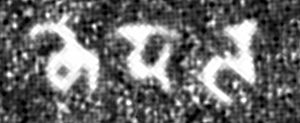
During the time of the Gupta Empire in India, the emperor Samudragupta wrote about Nepal. He called Nepal a "frontier kingdom" that paid a yearly tribute. This is written on Samudragupta's Allahabad Pillar inscription.
Licchavi Dynasty
The kings of the Lichhavi dynasty came from Vaishali in modern-day India. They ruled the Kathmandu valley after the Kirats. Some old writings say that "Suryavansi Kshetriyas" started a new rule by defeating the Kirats. The Pashupati Purana says that "the masters of Vaishali established their own rule by tricking Kiratis with kind words and defeating them in war." The Lichhavis took over Nepal by defeating the last Kirati King.
Nepal's Medieval History
Thakuri Dynasty
After Aramudi, a king mentioned in an old Kashmirian book, many Thakuri kings ruled parts of Nepal until the mid-12th century CE. Raghava Deva is said to have started a ruling family in 879 CE. This was when the Lichhavi rule ended. To remember this, Raghava Deva started the 'Nepal Era' on October 20, 879 CE.
Gunakama Deva ruled from 949 to 994 CE. He ordered the building of a large wooden shelter called Kasthamandapa. It was made from the wood of a single tree. The name of the capital, 'Kathmandu', comes from this building. Gunakama Deva also founded the town of Kantipur (which is modern-day Kathmandu). The festival of Indra Jatra began during his time.
Laxmikama Deva ruled from 1024 to 1040 CE. He built the Laksmi Vihara and started the tradition of worshiping the Kumari. These are young girls believed to be living goddesses. His son, Vijayakama Deva, followed him. Vijayakama Deva started the worship of the Naga (snake deities) and Vasuki. He was the last ruler of this family. After he died, the Thakuri family from Nuwakot took over the throne of Nepal.
Shankara Deva (1067–1080 CE) was a famous ruler of this dynasty. He started the custom of putting pictures of Nagas and Vasuki on house doors on Nagapanchami day.
After the Thakuri dynasty ended, a new family called the 'Malla dynasty' began to rule.
Malla Dynasty
The Malla rule began with Ari Malla in the 12th century. Over the next 200 years, their kingdom grew very large. It spread into much of India and western Tibet. But then it broke into smaller kingdoms, known as the Baise Rajya.
Jayasthiti Malla started the later Malla dynasty in the Kathmandu valley in the late 14th century. The Malla dynasty ruled for the longest time in Nepal's history, about 600 years (from the 12th to the 18th century). This time was important for many changes in the valley. New ways of measuring land and giving it out were introduced. New styles of art and buildings also appeared. The famous buildings in Kathmandu valley that are UNESCO World Heritage Sites were built during the Malla rule.
In the 14th century, before Kathmandu was split into three kingdoms, a skilled artist named Araniko was sent to China. He showed his amazing art and building skills there. He introduced the Pagoda style of building to China and then to all of Asia.
Yaksha Malla, the grandson of Jayasthiti Malla, ruled the Kathmandu valley until almost the end of the 15th century. After he died, the valley was divided into four separate kingdoms: Kathmandu, Bhaktapur, Patan, and Banepa. Banepa soon came under Bhaktapur's control. This division led to fights and wars between the Malla rulers. These wars made them weaker. This made it easier for Prithvi Narayan Shah of Gorkha to conquer the valley. The last Malla rulers were Jaya Prakash Malla, Teja Narasingha Malla, and Ranjit Malla of Kathmandu, Patan, and Bhaktapur.
Simroun Dynasty
The Simroun, or Karnat dynasty, started a kingdom in 1097 CE. Its main city was Simroungarh in Bara.
- Nanya Dev ruled from 1097-1147 CE.
- Harisingh Dev ruled from 1295-1324 CE.
In 1324 CE, Ghiyasuddin Tughlaq attacked Simroungarh and destroyed its fort. The king, Harisingh Dev, escaped north.
Shah Dynasty: Uniting Nepal
Prithvi Narayan Shah (around 1768–1775) was a descendant of Dravya Shah, who founded the Gorkha ruling family. Prithvi Narayan Shah became king of Gorkha in 1743 CE, after his father Nara Bhupal Shah. King Prithvi Narayan Shah knew a lot about the kingdoms in the valley and the smaller hill states. He saw that uniting these small areas was important for Nepal to survive. So, he started this big task.
He was right about the hill states. They were conquered quite easily. King Prithvi Narayan Shah's journey of victory began with taking over Nuwakot in 1744. Nuwakot is between Kathmandu and Gorkha. After Nuwakot, he took control of important places in the hills around the Kathmandu valley. This cut off the valley's connections to the outside world. Taking the Kuti Pass around 1756 stopped the valley's trade with Tibet.
Finally, Prithvi Narayan Shah entered the valley. After winning the Battle of Kirtipur, King Jaya Prakash Malla of Kathmandu asked the British for help. The East India Company sent soldiers in 1767. But the Gorkhali army defeated the British force in Sindhuli. This loss crushed King Jaya Prakash Malla's hopes.
On September 25, 1768, while people in Kathmandu were celebrating the Indra Jatra festival, the Gorkhali army marched into the city. Prithvi Narayan Shah sat on the throne meant for the king of Kathmandu, declaring himself king. Jaya Prakash Malla escaped and went to Patan. A few weeks later, Patan was captured. Both Jaya Prakash Malla and Tej Narsingh Malla, the king of Patan, took shelter in Bhaktapur. Bhaktapur was captured on November 25, 1769. This way, King Prithvi Narayan Shah conquered the Kathmandu valley. He made Kathmandu the royal capital of the Kingdom of Nepal.
King Prithvi Narayan Shah successfully brought many different religious and ethnic groups together under one rule. He was a true nationalist. He believed in keeping Nepal separate from British influence. His ideas about society and economy guided the country for a long time. He also used the image of "a yam between two boulders" to describe Nepal's position between its powerful neighbors. This idea became a main guide for Nepal's foreign policy for centuries.
Nepal's Modern History
The Kingdom of Nepal
After many years of competition between medieval kingdoms, modern Nepal was united in the late 1700s. Prithvi Narayan Shah, the ruler of a small area called Gorkha, brought many independent hill states together to form one country. After Prithvi Narayan Shah died, the Shah dynasty started to expand their kingdom into much of the Indian subcontinent.
Between 1788 and 1791, during the Sino-Nepalese War, Nepal invaded Tibet. They robbed the Tashilhunpo Monastery in Shigatse. China's Qianlong Emperor sent his army. The conflict ended in a draw.
After 1800, Prithvi Narayan Shah's descendants found it hard to keep strong control over Nepal. A time of internal trouble followed. Nepal and the British East India Company argued over areas near their borders. This led to the Anglo-Nepalese War (1814–16). Nepal lost a lot because it didn't have as many modern weapons as the British-Indian forces. The Treaty of Sugauli was signed in 1816. Nepal gave up large parts of its land to the British. In 1860, some parts of western Terai, called Naya Muluk (new country), were given back to Nepal.
Before the Rana dynasty rose to power, four noble families were very active in the kingdom's politics: the Shah rulers, the Thapas, the Basnyats, and the Pandes. From the early to mid-18th century, the Thapas and Pandes had a lot of power. They often fought each other for control.
Rana Rule
Jung Bahadur Rana was the first ruler from the Rana dynasty. Rana rulers were called "Shree Teen" and "Maharaja". The Shah kings were called "Shree Panch" and "Maharajadhiraja". Jung Bahadur created new laws and updated the government. In a sudden takeover in 1846, Jung Bahadur's nephews killed Ranodip Singh and Jung Bahadur's sons. They took the name Jung Bahadur and gained control of Nepal. Nine Rana rulers held the position of Prime Minister, which was passed down in their family.
The Rana government was a very strict system where one family had all the power. They tried to keep Nepal separate from outside influences. This helped Nepal stay independent during the British colonial period. But it also slowed down the country's economic growth and modernization. The Ranas strongly supported the British. They helped the British during the Indian Rebellion of 1857 and later in both World Wars. In December 1923, Britain and Nepal signed a "treaty of perpetual peace and friendship". This replaced the 1816 Sugauli Treaty and recognized Nepal's independence.
Slavery was ended in Nepal in 1924. This happened when Chandra Shamsher Jang Bahadur Rana was Prime Minister.
When Germany invaded Poland, the Kingdom of Nepal declared war on Germany on September 4, 1939. When Japan joined the war, sixteen groups of the Nepali Army fought in Burma. Nepal also gave guns, equipment, and raw materials like timber to the Allied war effort.
The 1951 Revolution
People started to become unhappy with the Rana family's rule. This unhappiness came from educated Nepalis who had studied abroad. It also came from some Ranas who felt left out of the ruling family. Many Nepalis living outside the country had helped in the Indian Independence struggle. They wanted to free Nepal from the strict Rana government too.
Political parties like the Praja Parishad and Nepali Congress were formed by leaders like B. P. Koirala and Ganesh Man Singh. They urged for a military and popular movement in Nepal to overthrow the Rana rule. The Nepali Congress also created a military group. Some brave people, like Dharma Bhakta Mathema and Shukraraj Shastri, were killed by the Ranas for their beliefs.
This unrest led to King Tribhuvan, a direct descendant of Prithvi Narayan Shah, escaping to India in 1950. This sparked an armed uprising against the Rana government. Eventually, the Shah family returned to power. A non-Rana person became prime minister after an agreement called the 'Delhi Compromise'.
A period of semi-constitutional rule followed. The king, with help from new political parties, governed the country. In the 1950s, efforts were made to create a constitution for Nepal. This constitution would set up a government where people had representatives, similar to the British system. A cabinet with 10 members was formed. It had 5 Ranas and 5 Nepali Congress members. This government drafted the 'Interim Government Act', which was Nepal's first constitution. But this government didn't work well together. So, in November 1951, the king formed a new government.
Panchayat System
The first democratic elections were held in 1959. B. P. Koirala was elected prime minister. But 18 months later, in 1960, King Mahendra staged a royal takeover. He said that parliamentary democracy had failed. He removed the elected Koirala government and announced that Nepal would be governed by a "partyless" system. He introduced a new constitution on December 16, 1960. The elected prime minister, members of parliament, and many democratic activists were arrested.
The new constitution created a "partyless" Panchayat system. King Mahendra believed this was a democratic government that fit Nepalese traditions better. This system was like a pyramid, going from village meetings up to the Rastriya Panchayat. It made the king's power absolute. The king was the head of state and had full control over all government groups, including the cabinet and parliament. The policy of "one-state-one-language" was adopted. This aimed to unite different ethnic and regional groups into one Nepali national identity. The Back to Village Campaign started in 1967. It was a main program for rural development under the Panchayat system.
King Mahendra died in 1972. His 27-year-old son, King Birendra, took over. In 1979, there were student protests and activities against the government. King Birendra then asked for a national vote. People would decide if they wanted the Panchayat system to continue with some democratic changes, or if they wanted a system with many political parties. The vote was held in May 1980. The Panchayat system won by a small margin. The king then made the promised changes, including letting the Rastriya Panchayat choose the prime minister.
Multiparty Democracy
People in rural areas hoped their needs would be better heard after parliamentary democracy was adopted in 1990. The Nepali Congress, with help from the United Left Front, decided to start a strong protest movement. This was the Jana Andolan, or People's Movement. It forced the monarchy to accept changes to the constitution and create a parliament with many parties. In May 1991, Nepal held its first parliamentary elections in almost 50 years. The Nepali Congress won 110 out of 205 seats. They formed the first elected government in 32 years.
In 1992, Nepal faced economic problems and chaos. Prices went up because of new government policies. Radical left-wing groups increased their protests. A Joint People's Agitation Committee was formed. A general strike was called for April 6. Violence started the day before the strike. The Agitation Committee called for a 30-minute 'lights out' in the capital. Violence broke out when activists tried to enforce this. On April 6, clashes between strikers and police happened outside a police station. Two activists died. Later, police attacked a large rally in Tundikhel in Kathmandu. Riots started, and a building was set on fire. Police shot into the crowd, killing several people.
When promised land reforms didn't happen, people in some areas started to organize. They wanted to make their own land reforms and gain power over their lives. But the Nepali government stopped this movement. Many leading activists were killed. This made many people who saw the repression become more radical.
Nepalese Civil War
In March 1997, the Communist Party of Nepal (Maoist) began a plan to replace the monarchy with a new people's democratic republic. They used a revolutionary strategy called the people's war. This led to the Nepalese Civil War. Dr. Baburam Bhattarai and Pushpa Kamal Dahal (also known as "Prachanda") led the uprising. It started in five districts in Nepal: Rolpa, Rukum, Jajarkot, Gorkha, and Sindhuli. The Communist Party of Nepal (Maoist) set up a temporary "people's government" in several areas.
The rebellion grew stronger. In October 2002, the king temporarily removed the government and took full control. A week later, he appointed another government, but the country was still very unstable.
The Maoists took over large parts of Nepal. They removed government representatives and took property from local "capitalists." They also started their own development projects. They even ran their own prisons and courts. Besides using force, the Maoists gained support because they were popular with many Nepalis. This included women, untouchables, and ethnic minorities. They ended caste discrimination, gave women equal inheritance rights, and stopped forced marriages. The Maoists also offered free healthcare and reading classes.
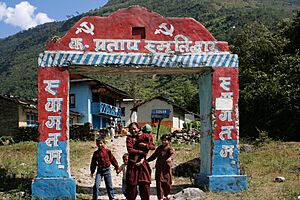
Governments were unstable, and the Kathmandu Valley was under attack in August 2004. Support for the monarchy started to decrease. On February 1, 2005, King Gyanendra fired the entire government. He took all executive powers and declared a state of emergency to stop the revolution. Politicians were put under house arrest. Phone and internet lines were cut, and freedom of the press was greatly limited.
The king's new government made little progress in stopping the rebels. Local elections in February 2006 were called "a backward step for democracy" by the European Union. Major parties did not participate, and some candidates were forced to run by the army. In April 2006, strikes and street protests in Kathmandu forced the king to bring back the parliament. A seven-party coalition took control of the government again. They took away most of the king's powers. On December 24, 2007, seven parties, including the former Maoist rebels and the ruling party, agreed to end the monarchy. They decided to declare Nepal a federal republic. In the elections on April 10, 2008, the Maoists won a simple majority. They looked set to form a government for the new 'Republic of Nepal'.
From 1996 to 2006, the war caused about 13,000 deaths.
Republic of Nepal
On May 28, 2008, the newly elected Constituent Assembly declared Nepal a Federal Democratic Republic. This ended the 240-year-old monarchy. The vote to end the monarchy passed by a huge majority: 560 members voted for it, and only 4 voted against it. On June 11, 2008, the former King Gyanendra left the palace. Ram Baran Yadav of the Nepali Congress became the first President of the Federal Democratic Republic of Nepal on July 23, 2008. Then, the Constituent Assembly elected Pushpa Kamal Dahal (Prachanda) of the Unified Communist Party of Nepal (Maoist) as the first Prime Minister of the republic on August 15, 2008.
The Constituent Assembly failed to write a constitution by the deadline. So, the government dissolved it on May 28, 2012. A new temporary government was formed. It was led by the Chief Justice of Nepal, Khil Raj Regmi. In the Constituent Assembly election in November 2013, the Nepali Congress won the most votes but not a majority. The CPN (UML) and the Nepali Congress worked together to form a government. Sushil Koirala of the Nepali Congress was elected prime minister. The Constitution of Nepal was finally adopted on September 20, 2015.
On April 25, 2015, a very strong earthquake (magnitude 7.8) hit Nepal. It killed almost 9,000 people and injured nearly 22,000. It was the worst natural disaster in the country since 1934. The earthquake also caused an avalanche on Mount Everest, killing 21 people. Very old buildings, including UNESCO World Heritage Sites in the Kathmandu valley, were destroyed. A big aftershock happened on May 12, 2015. It killed over 200 people and injured more than 2,500. Many people lost their homes. These events led to a major humanitarian crisis.
Minority groups like Madhesi and Tharu protested strongly against the new constitution. They felt their concerns were not addressed. They also felt there were not enough clear protections for their groups in the document. At least 56 civilians and 11 police died in clashes over the constitution. In response to the Madhesi protests, India stopped vital supplies to Nepal. India said this was due to insecurity and violence in border areas. The then prime minister of Nepal, KP Sharma Oli, publicly accused India of the blockade. He called it more inhumane than war. India denied causing the blockade. The blockade stopped imports of not only fuel but also medicines and earthquake relief supplies. The then United Nations Secretary-General, Ban Ki-moon, said that stopping fuel and medicine to Nepal was a violation of human rights. This made the humanitarian crisis worse.
2017 to Present
In June 2017, Nepali Congress leader Sher Bahadur Deuba became the 40th Prime Minister of Nepal. He took over from Pushpa Kamal Dahal. Deuba had been Prime Minister before, several times. In November 2017, Nepal had its first general election since the civil war ended and the monarchy was abolished. The main choices were the Nepali Congress Party and an alliance of former Maoist rebels and the Communist UML party. The communist alliance won the election. UML leader Khadga Prasad Sharma Oli became the new Prime Minister in February 2018. He had also been Prime Minister from 2015 to 2016.
In March 2018, President Bidya Devi Bhandari was re-elected for a second term. She was the candidate of the ruling Left alliance. The president's job is mostly ceremonial.
In July 2021, Prime Minister Oli was replaced by Sher Bahadur Deuba after some political problems.
In December 2022, former Maoist leader Pushpa Kamal Dahal, also known as Prachanda, became Nepal's new prime minister. This happened after the general election.
In March 2023, Ram Chandra Paudel of the Nepali Congress was elected as Nepal’s third president. He took over from Bidya Devi Bhandari.
Images for kids
See Also
 In Spanish: Historia de Nepal para niños
In Spanish: Historia de Nepal para niños
- History of Asia
- History of India
- History of Kathmandu
- History of Sikkim
- Monarchy of Nepal
- Politics of Nepal
Sources
- Michaels, Axel, et al. "Nepalese History in a European Experience: A Case Study in Transcultural Historiography." History and Theory 55.2 (2016): 210–232.
- Garzilli, Enrica, "A Sanskrit Letter Written by Sylvain Lévi in 1923 to Hemarāja Śarmā Along With Some Hitherto Unknown Biographical Notes (Cultural Nationalism and Internationalism in the First Half of the 21st Cent.: Famous Indologists Write to the Raj Guru of Nepal – no. 1), in Commemorative Volume for about 30 Years of the Nepal-German Manuscript Preservation Project. Journal of the Nepal Research Centre, XII (2001), Kathmandu, ed. by A. Wezler in collaboration with H. Haffner, A. Michaels, B. Kölver, M. R. Pant and D. Jackson, pp. 115–149.
- Garzilli, Enrica, "Strage a palazzo, movimento dei Maoisti e crisi di governabilità in Nepal", in Asia Major 2002, pp. 143–160.
- Garzilli, Enrica, "Il nuovo Stato del Nepal: il difficile cammino dalla monarchia assoluta alla democrazia", in Asia Major 2005-2006, pp. 229–251.
- Garzilli, Enrica, "Il Nepal da monarchia a stato federale", in Asia Major 2008, pp. 163–181.
- Garzilli, Enrica, "La fine dell'isolamento del Nepal, la costruzione della sua identità politica e delle sue alleanze regionali" in ISPI: Istituto per gli Studi di Politica Internazionali, CVII (Nov. 2008), pp. 1–7;
- Garzilli, Enrica, "Le elezioni dell'Assemblea Costituente e i primi mesi di governo della Repubblica Democratica Federale del Nepal", in Asia Maior 2010, pp. 115–126.
- Garzilli, Enrica, "Nepal, la difficile costruzione della nazione: un paese senza Costituzione e un parlamento senza primo ministro", in Asia Maior 2011, pp. 161–171.
- Garzilli, Enrica, "The Interplay between Gender, Religion and Politics, and the New Violence against Women in Nepal", in J. Dragsbæk Schmidt and T. Roedel Berg (eds.), Gender, Social Change and the Media: Perspective from Nepal, University of Aalborg and Rawat Publications, Aalborg-Jaipur: 2012, pp. 27–91.
- Garzilli, Enrica, "Nepal, stallo politico e lentezze nella realizzazione del processo di pace e di riconciliazione", in Asia Maior 2012, pp. 213–222.
- Garzilli, Enrica, "A Sanskrit Letter Written by Sylvain Lévy in 1925 to Hemarāja Śarmā along with Some Hitherto Unknown Biographical Notes (Cultural Nationalism and Internationalism in the First Half of the 20th Century – Famous Indologists write to the Raj Guru of Nepal – No. 2)", in History of Indological Studies. Papers of the 12th World Sanskrit Conference Vol. 11.2, ed. by K. Karttunen, P. Koskikallio and A. Parpola, Motilal Banarsidass and University of Helsinki, Delhi 2015, pp. 17–53.
- Garzilli, Enrica, "Nepal 2013-2014: Breaking the Political Impasse", in Asia Maior 2014, pp. 87–98.
- Tiwari, Sudarshan Raj (2002). The Brick and the Bull: An account of Handigaun, the Ancient Capital of Nepal. Himal Books. ISBN: 99933-43-52-8.
- Kayastha, Chhatra Bahadur (2003).Nepal Sanskriti: Samanyajnan. Nepal Sanskriti. ISBN: 99933-34-84-7.
- Stiller, Ludwig (1993): Nepal: growth of a nation, HRDRC, Kathmandu, 1993, 215pp.


